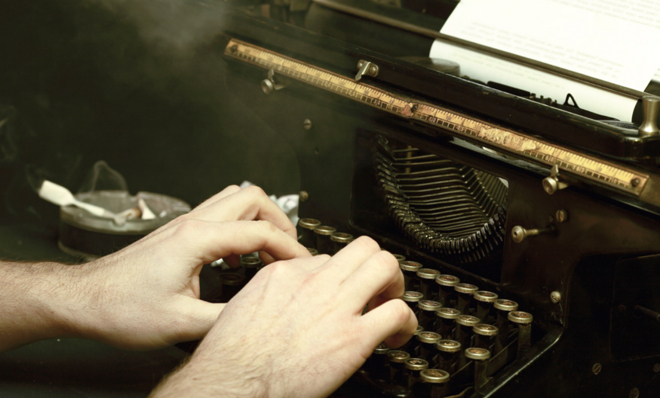How many spaces should there be at the end of a sentence?
Grammar nerds, sharpen your swords!


The question of whether you should put one or two spaces after the period at the end of a sentence elicits strong reactions on both sides. On the one-space side, this 2011 Slate article by Farhad Manjoo (which has over 165,000 Facebook likes) lays out the argument for why "typing two spaces after a period is totally, completely, utterly, and inarguably wrong." Basically, it comes down to aesthetics, with Manjoo maintaining that "one space is simpler, cleaner, and more visually pleasing." The two-space side, however, has its own idea of what's visually pleasing, as forcefully argued in this comment to the Chicago Manual of Style Online:
About two spaces after a period. As a U.S. Marine, I know that what's right is right and you are wrong. I declare it once and for all aesthetically more appealing to have two spaces after a period. If you refuse to alter your bullheadedness, I will petition the commandant to allow me to take one Marine detail to conquer your organization and impose my rule. Thou shalt place two spaces after a period. Period. Semper Fidelis.
The Chicago Manual of Style recommends, as most modern style guides do, the one-space rule.
Why is this a question?
The Week
Escape your echo chamber. Get the facts behind the news, plus analysis from multiple perspectives.

Sign up for The Week's Free Newsletters
From our morning news briefing to a weekly Good News Newsletter, get the best of The Week delivered directly to your inbox.
From our morning news briefing to a weekly Good News Newsletter, get the best of The Week delivered directly to your inbox.
The reason there is a conflict about this at all is because things changed. Early standards for typesetting used a larger space after sentences than between words. The space between sentences was an em space, or the width of a capital M, and the space between words was one-third of that. You can see the difference in this excerpt from the 1910 edition of the Chicago Manual of Style (which at that time endorsed the larger space after sentences):

For a few hundred years, the whole issue of text spacing was the province of printers and typesetters, and the average writer never had to think about it. Then along came the typewriter, and suddenly everyone could produce printed texts. The em space spacing standard was approximated on the typewriter by using one space after words and two after sentences. And everybody learned to type that way.
But in the middle of the 20th century, the standard started to change. New typesetting technology used by printing companies made it easier and more economical to print texts with uniform spacing. People got used to seeing this style of printed text, and many thought it looked cleaner and better. But not everyone thought so, and a conflict was born. Plus, typists had gotten used to a double-spacing thumb action that was hard to unlearn, and was transferred, through typing teachers, to the next few generations. So even when people didn't care one way or the other about the spacing in the texts they read, when they themselves were doing the typing, they preferred to stick with the way they learned it.
Which is better?
A free daily email with the biggest news stories of the day – and the best features from TheWeek.com
Some people think the double space looks messy because it leaves holes and "rivers" in blocks of text. Some people think the double space makes it easier to process sentence breaks. Some people think it's easier to type one space, because why do something twice when you can do it once? Some people think it's easier to type two spaces because that's how they learned it. It would seem, then, that the spacing question is a matter of opinion. Certainly, as the Economist's Prospero Blog points out, it is not a matter of grammar. It doesn't have as much to do with language as it does with typing, or graphic design.
Still, even if you don't have any opinion on the matter, when you're typing something up, you've got to choose one or the other. If you are writing for someone to whom it matters — your boss, your editor, your teacher, your grandma — then you should use the standard they prefer (or the style guide they follow).
These days, the two-space style is sometimes preferred for pre-publication manuscripts (e.g., as stipulated in the American Psychological Association publication guidelines), but most work is published with the one-space style. If you're texting on your iPhone you can have it both ways — a quick double-space with your thumb will come out as a period with one space after it. That shortcut pairs the traditional typing action with the modern look, reconciling both factions through technology, the very thing that drove the wedge between them in the first place.
Arika Okrent is editor-at-large at TheWeek.com and a frequent contributor to Mental Floss. She is the author of In the Land of Invented Languages, a history of the attempt to build a better language. She holds a doctorate in linguistics and a first-level certification in Klingon. Follow her on Twitter.
-
 Political cartoons for January 17
Political cartoons for January 17Cartoons Saturday’s political cartoons include hard hats, compliance, and more
-
 Ultimate pasta alla Norma
Ultimate pasta alla NormaThe Week Recommends White miso and eggplant enrich the flavour of this classic pasta dish
-
 Death in Minneapolis: a shooting dividing the US
Death in Minneapolis: a shooting dividing the USIn the Spotlight Federal response to Renee Good’s shooting suggest priority is ‘vilifying Trump’s perceived enemies rather than informing the public’
